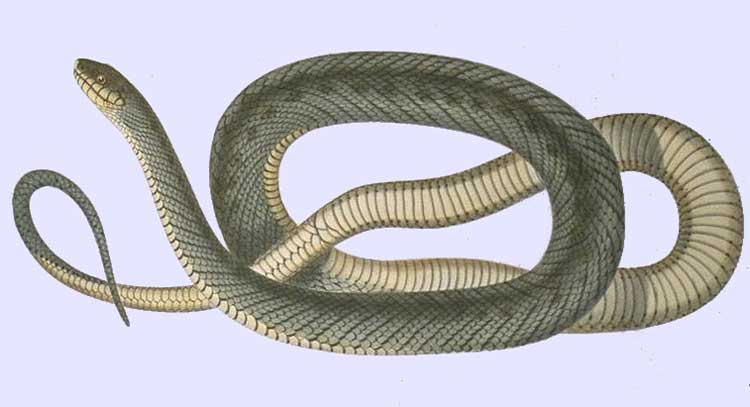
Philodryas patagoniensis
Superregnum: Eukaryota
Regnum: Animalia
Subregnum: Eumetazoa
Cladus: Bilateria
Cladus: Nephrozoa
Superphylum: Deuterostomia
Phylum: Chordata
Subphylum: Vertebrata
Infraphylum: Gnathostomata
Megaclassis: Osteichthyes
Superclassis: Sarcopterygii
Superclassis: Tetrapoda
Cladus: Reptiliomorpha
Cladus: Amniota
Classis: Reptilia
Cladus: Eureptilia
Cladus: Romeriida
Subclassis: Diapsida
Cladus: Sauria
Infraclassis: Lepidosauromorpha
Superordo: Lepidosauria
Ordo: Squamata
Subordo: Serpentes
Infraordo: Caenophidia
Superfamilia: Colubroidea
Familia: Dipsadidae
Subfamilia: Xenodontinae
Genus: Philodryas
Species: Philodryas patagoniensis
Name
Philodryas patagoniensis (Girard, 1858)
References
Links
Uetz, P. & Hallermann, J. 2022. Philodryas patagoniensis. The Reptile Database. Accessed on 1 October 2019.
Vernacular names
English: Patagonia Green Racer
Philodryas patagoniensis, also known as the Patagonia green racer, is a species of rear-fanged (opisthoglyphous) venomous snake in the family Colubridae. The species is endemic to cis-Andean South America from northern Argentina to northeastern Brazil; despite its name, most of its range is outside Patagonia.[1][2]
Description
P. patagoniensis is a medium-sized, cylindrical and robust snake, with a moderately long tail. It can grow to a maximum total length (including tail) of 150 cm (59 in). The snout is rounded. The eye is medium-sized with a round pupil. The dorsal scales are smooth with unique apical scores.[3]
Behavior
P. patagoniensis is terrestrial, fundamentally arboreal when foraging, and has daytime habits. It has a brownish color that helps in its camouflage.[4]
Sexual dimorphism and reproduction
P. patagoniensis has sexual dimorphism in adult specimens. Females have a longer body, with greater corpulence, while males have a longer tail. Females are born with a greater rostro-cloacal length and reach sexual maturity later than males, about 2-years-old. Males can reach sexual maturity at 1-year-old. Reproduction is seasonal, with the vitellogenic season occurring between the months of July and October.[4]
Diet
P. patagoniensis preys upon snakes including its own species. Juveniles feed on ectothermic animals, while adults feed on endothermic animals.[4]
Predators
P. patagoniensis is preyed upon by birds such as Cariama cristata and Tyto alba, as well as other snakes such as Boiruna maculata.[4]
Geographic range
P. patagoniensis is found in Argentina, Bolivia, Brazil, Paraguay, and Uruguay.[1][2]
Habitat
P. patagoniensis occurs in a range of open habitats including Patagonian steppe, Cerrado, Chaco, and Caatinga, and also open areas of the Atlantic forest.[1]
Common names
Common names for P. patagoniensis include corre campo, parelheira, parelheira comum, papa pinto, culebra del alfa, culebra de los pastos, ratonera, and mboi hovy.[3]
Venom
P. patagoniensis produces toxic saliva through the Duvernoy's gland. Its toxin is constituted by 90% protein, mainly metalloproteinases. The biological activity of the toxins is very similar to that of Bothrops, with edematogenic, hemorrhagic, nociceptive, and necrosis activity of this compound. This species has an LD50 of 58.58 µg / mouse, a value close to Bothrops jararacussu with 58.8 µg / mouse, its toxicity is between Bothrops alternatus with 67.5 µg / mouse and Bothrops jararaca with 24.7 µg / mouse. However, P. patagoniensis has opisthoglyphous dentition and has difficulty injecting venom.[4] Its venom also contains neurotoxic and myotoxic components, which result in neuromuscular block and myonecrosis.[5]
References
Arzamendia, V.; Giraudo, A.; Scott, N.; Scrocchi, G. (2019). "Philodryas patagoniensis". IUCN Red List of Threatened Species. 2019: e.T15182036A15182048. doi:10.2305/IUCN.UK.2019-3.RLTS.T15182036A15182048.en. Retrieved 20 November 2021.
Philodryas patagoniensis at the Reptarium.cz Reptile Database. Accessed 23 March 2021.
"WCH Clinical Toxinology Resources". www.toxinology.com. Retrieved 15 June 2021.
Costa, Márcio Taveres (2016). Avaliações Toxicológicas da Zootoxina de Philodryas patagoniensis (Serpente (sic): Dipsadidae) [Toxicological Evaluations of the Zootoxin of Philodryas patagoniensis (Serpentes: Dipsadidae)] (PDF) (Dissertation for Master's Degree in Biochemistry) (in Portuguese). Uruguaiana, Rio Grande do Sul, Brazil: Universidade Federal do Pampa. 62 pp.
Costa, Roberta Silva Carreiro (2007). Ação neuromuscular da peçonha da colubridea opistóglifa Philodryas patagoniensis em preparações de aves e mamíferos: caracterização parcial do(s) componente(s) ativo(s) [Neuromuscular Action of the Opisthoglyphous Colubrid Philodryas patagoniensis in Avian and Mammal Preparations: Partial Characterization of Active Component(s)] (PDF) (Dissertation for Master's Degree in Biological Sciences) (in Portuguese). São José dos Campos, São Paulo, Brazil: Universidade do Vale do Paraíba. 81 pp.
Further reading
Freiberg M (1982). Snakes of South America. Hong Kong: T.F.H. Publications. 189 pp. ISBN 0-87666-912-7. (Philodryas patagoniensis, pp. 106, 140 + photographs of juveniles and adult on p. 147).
Girard C (1858). "Descriptions of some new Reptiles, collected by the U. S. Exploring Expedition, under the command of Capt. Charles Wilkes, U. S. N. Third Part.—Including the species of Ophidians, exotic to North America". Proceedings of the Academy of Natural Sciences of Philadelphia 9: 181–182. (Callirhinus patagoniensis, new species, p. 182).
Melo-Sampaio PR, Passos P, Martins AR, Jennings WB, Moura-Leite JC, Morato SAA, Venegas PJ, Chávez G, Venâncio NM, Souza MB (2020). "A phantom on the trees: Integrative taxonomy supports a reappraisal of rear-fanged snakes classification (Dipsadidae: Philodryadini)". Zoologischer Anzeiger 290: 19–39. (Pseudablabes patagoniensis, new combination). (Published online 2020; print edition 2021).
Retrieved from "http://en.wikipedia.org/"
All text is available under the terms of the GNU Free Documentation License

